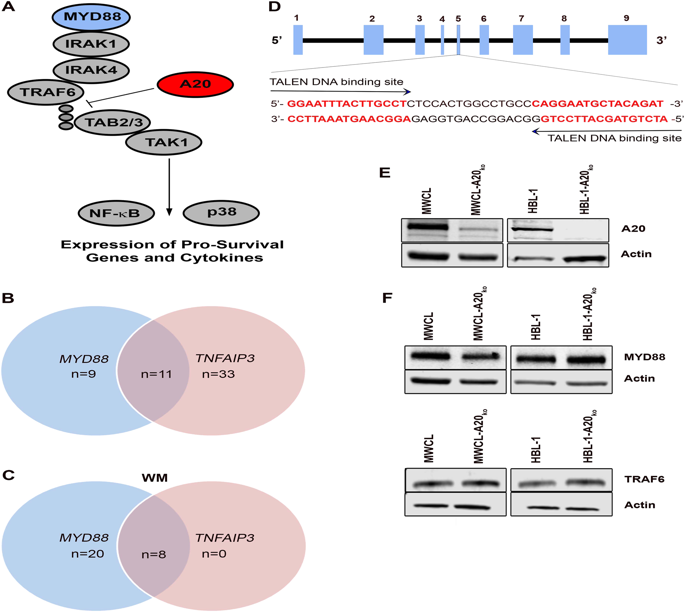当前位置:
X-MOL 学术
›
Blood Cancer J.
›
论文详情
Our official English website, www.x-mol.net, welcomes your
feedback! (Note: you will need to create a separate account there.)
Loss of TNFAIP3 enhances MYD88L265P-driven signaling in non-Hodgkin lymphoma.
Blood Cancer Journal ( IF 12.9 ) Pub Date : 2018-Oct-09 , DOI: 10.1038/s41408-018-0130-3
Kerstin Wenzl 1 , Michelle K Manske 1 , Vivekananda Sarangi 2 , Yan W Asmann 3 , Patricia T Greipp 4 , Hanna R Schoon 1 , Esteban Braggio 5 , Matthew J Maurer 2 , Andrew L Feldman 6 , Thomas E Witzig 1 , Susan L Slager 2 , Stephen M Ansell 1 , James R Cerhan 2 , Anne J Novak 1
Blood Cancer Journal ( IF 12.9 ) Pub Date : 2018-Oct-09 , DOI: 10.1038/s41408-018-0130-3
Kerstin Wenzl 1 , Michelle K Manske 1 , Vivekananda Sarangi 2 , Yan W Asmann 3 , Patricia T Greipp 4 , Hanna R Schoon 1 , Esteban Braggio 5 , Matthew J Maurer 2 , Andrew L Feldman 6 , Thomas E Witzig 1 , Susan L Slager 2 , Stephen M Ansell 1 , James R Cerhan 2 , Anne J Novak 1
Affiliation

|
MYD88 mutations are one of the most recurrent mutations in hematologic malignancies. However, recent mouse models suggest that MYD88L265P alone may not be sufficient to induce tumor formation. Interplay between MYD88L265P and other genetic events is further supported by the fact that TNFAIP3 (A20) inactivation often accompanies MYD88L265P. However, we are still lacking information about the consequence of MYD88L265P in combination with TNFAIP3 loss in human B cell lymphoma. Review of our genetic data on diffuse large B cell lymphoma (DLBCL) and Waldenstrom macroglobulinemia (WM), found that a large percentage of DLBCL and WM cases that have a MYD88 mutation also harbor a TNFAIP3 loss, 55% DLBCL and 28% of WM, respectively. To mimic this combination of genetic events, we used genomic editing technology to knock out TNFAIP3 in MYD88L265P non-Hodgkin's lymphoma (NHL) cell lines. Loss of A20 expression resulted in increased NF-κB and p38 activity leading to upregulation of the NF-κB target genes BCL2 and MYC. Furthermore, we detected the increased production of IL-6 and CXCL10 which led to an upregulation of the JAK/STAT pathway. Overall, these results suggest that MYD88L265P signaling can be enhanced by a second genetic alteration in TNFAIP3 and highlights a potential opportunity for therapeutic targeting.
中文翻译:

TNFAIP3 的缺失增强了非霍奇金淋巴瘤中 MYD88L265P 驱动的信号传导。
MYD88 突变是血液系统恶性肿瘤中最常见的突变之一。然而,最近的小鼠模型表明,单独的 MYD88 L265P可能不足以诱导肿瘤形成。TNFAIP3 (A20) 失活经常伴随 MYD88 L265P的事实进一步支持了 MYD88 L265P与其他遗传事件之间的相互作用。然而,我们仍然缺乏有关 MYD88 L265P与 TNFAIP3 缺失联合治疗人 B 细胞淋巴瘤的后果的信息。回顾我们关于弥漫性大 B 细胞淋巴瘤 (DLBCL) 和华氏巨球蛋白血症 (WM) 的遗传数据,发现大部分具有 MYD88 突变的 DLBCL 和 WM 病例也存在 TNFAIP3 缺失,其中 55% 的 DLBCL 和 28% 的 WM 存在 TNFAIP3 缺失。 , 分别。为了模拟这种遗传事件的组合,我们使用基因组编辑技术敲除 MYD88 L265P非霍奇金淋巴瘤 (NHL) 细胞系中的 TNFAIP3。A20 表达缺失导致 NF-κB 和 p38 活性增加,从而导致 NF-κB 靶基因 BCL2 和 MYC 上调。此外,我们检测到 IL-6 和 CXCL10 产量增加,导致 JAK/STAT 通路上调。总体而言,这些结果表明TNFAIP3 的第二次基因改变可以增强MYD88 L265P信号传导,并强调了治疗靶向的潜在机会。
更新日期:2019-01-26
中文翻译:

TNFAIP3 的缺失增强了非霍奇金淋巴瘤中 MYD88L265P 驱动的信号传导。
MYD88 突变是血液系统恶性肿瘤中最常见的突变之一。然而,最近的小鼠模型表明,单独的 MYD88 L265P可能不足以诱导肿瘤形成。TNFAIP3 (A20) 失活经常伴随 MYD88 L265P的事实进一步支持了 MYD88 L265P与其他遗传事件之间的相互作用。然而,我们仍然缺乏有关 MYD88 L265P与 TNFAIP3 缺失联合治疗人 B 细胞淋巴瘤的后果的信息。回顾我们关于弥漫性大 B 细胞淋巴瘤 (DLBCL) 和华氏巨球蛋白血症 (WM) 的遗传数据,发现大部分具有 MYD88 突变的 DLBCL 和 WM 病例也存在 TNFAIP3 缺失,其中 55% 的 DLBCL 和 28% 的 WM 存在 TNFAIP3 缺失。 , 分别。为了模拟这种遗传事件的组合,我们使用基因组编辑技术敲除 MYD88 L265P非霍奇金淋巴瘤 (NHL) 细胞系中的 TNFAIP3。A20 表达缺失导致 NF-κB 和 p38 活性增加,从而导致 NF-κB 靶基因 BCL2 和 MYC 上调。此外,我们检测到 IL-6 和 CXCL10 产量增加,导致 JAK/STAT 通路上调。总体而言,这些结果表明TNFAIP3 的第二次基因改变可以增强MYD88 L265P信号传导,并强调了治疗靶向的潜在机会。







































 京公网安备 11010802027423号
京公网安备 11010802027423号